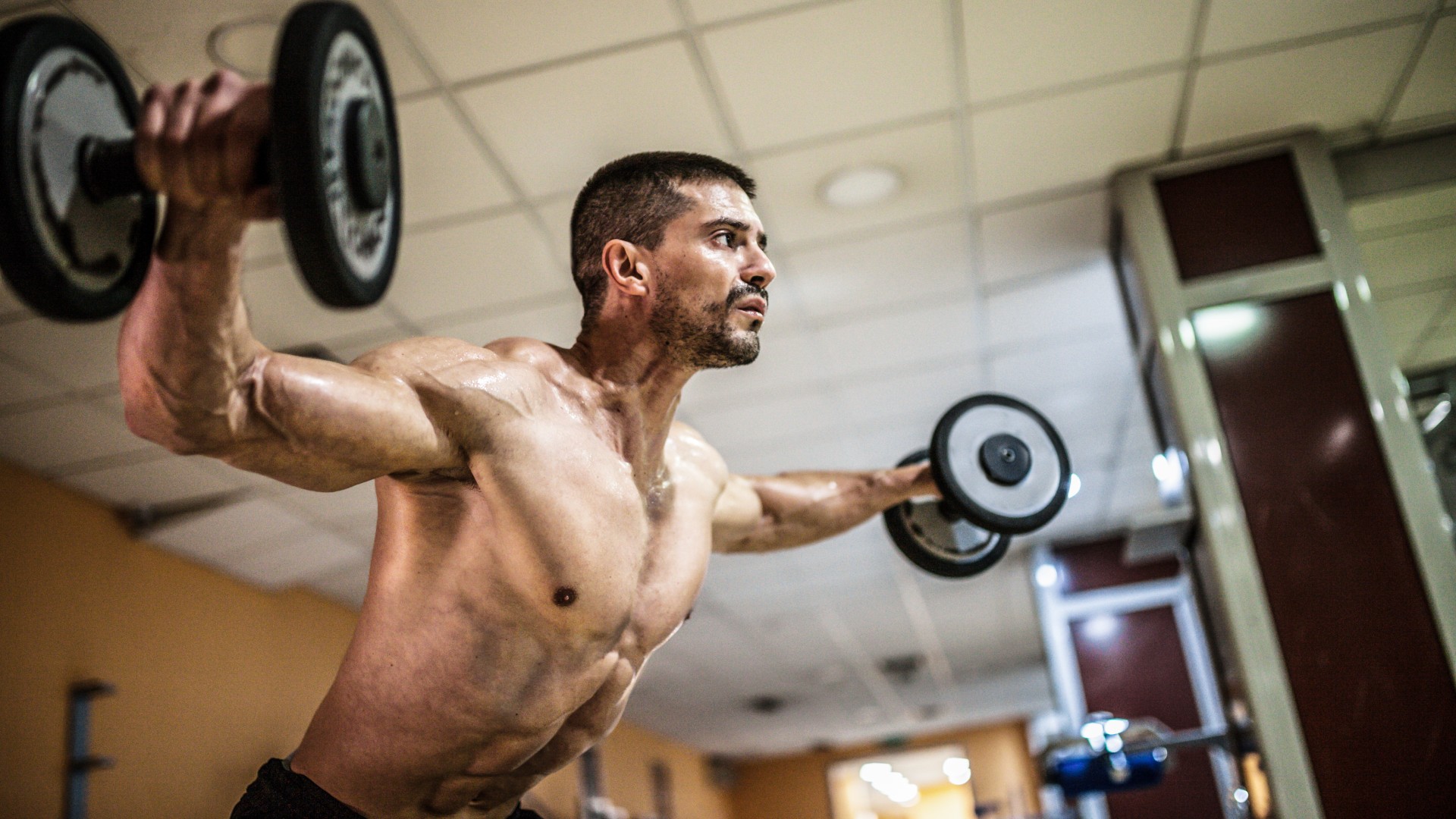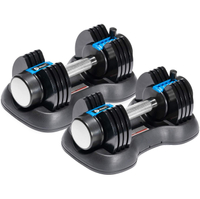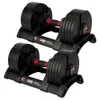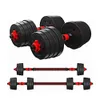
Here are five dumbbell exercises that can build your back and biceps muscles without a load of gym equipment.
You can build your back and biceps using a medium-heavy set of weights like the best adjustable dumbbells and progressively overload your muscles using weight, volume, or both. Add these to your existing program or use them as a standalone resistance circuit.
You won’t need to master pull-ups, muscle-ups, or load heavy on the barbells to build upper body strength and muscle, but you’ll need to be consistent in your routine. Here’s how.
What are the 5 back and biceps exercises?
A mix of compound and isolation exercises will keep you mentally and physically stimulated in the gym, so if you’re short on ideas, give these five dumbbell exercises a try.
These moves hit multiple upper-body muscle groups and strengthen your core. Barbells help you load heavier, helping you find an adequate weight for the larger, more powerful muscles in your back, like the lats and traps.
I like using dumbbells because you can increase your range of motion and recruit smaller, stabilizing muscles that help support movement, including your biceps.
Lifepro Adjustable Dumbbells (25 lbs): was $200 now $170 at Amazon
These budget-friendly weights are 15% less right now, and are adjustable between 5 lbs and 25 lbs each in 5 lb increments. They come with a storage tray and a knurled handle for improved grip.
1. Dumbbell renegade row
Renegade rows hit the chest, fronts of the shoulders and triceps during the push-up, abs during the plank and lats and rhomboids during the row. Here’s what happened when we tried renegade rows every day for one week.
Sign up to get the BEST of Tom's Guide direct to your inbox.
Get instant access to breaking news, the hottest reviews, great deals and helpful tips.
- Start in a high plank position, holding the handles of the dumbbells
- Stack your shoulders directly over your wrists and position your legs shoulder-width apart for stability
- Brace your stomach and glutes, and align your hips with your shoulders
- Row one dumbbell toward your hip, keeping your arm close to your torso. Your hips and shoulders should remain square to the floor
- Lower back to the starting position and repeat with the other arm
- Pause at the top of each row and squeeze your back
2. Dumbbell alternating row
Alternating rows work the left and right sides of the body independently from each other (known as unilateral training) while teaching the body to stabilize, balance and coordinate. We've demonstrated using kettlebells but you can easily use dumbbells for this exercise.
- Stand holding your dumbbells with feet hip-width apart
- Hinge forward the hips and send your bum backward, keeping a flat back and your core engaged
- Your chest should be nearly parallel to the floor
- Hold your dumbbells in front of your body with palms facing each other
- Row your left arm backward, drawing the dumbbell toward your left hip
- Pause. Lower your left arm to the starting position as you row your right dumbbell toward your right hip
- Continue alternating sides, keeping your hips square
3. Dumbbell farmer's walk
The farmer’s walk is a full-body exercise, building a stronger back and boosting balance, overall strength and stability. Here’s how to do the farmer’s walk in more detail.
- Stand with your feet hip or shoulder-width apart and hold a dumbbell in each hand
- Engage your core, lift your chest and squeeze your shoulder blades together, standing tall
- Begin walking without leaning forward, backward, or over to one side
- Consciously squeeze as many muscles as possible
4. Dumbbell W raises
W raises strengthen the upper and mid back, including your upper and mid trapezius muscles and posterior deltoids. The exercise also recruits the shoulder stabilizers known as the rotator cuffs, and your hips, lower back, abs and glutes.
- Stand holding a dumbbell in each hand
- Hinge forward at the hips and send your bum backward, maintaining a flat back and bracing your stomach
- Bend your elbows to 90 degrees and draw your arms up to create a W-shape with your body
- Squeeze your shoulder blades together and externally rotate your shoulders
- Pause, then return to the starting position
5. Dumbbell gorilla row
The gorilla row strengthens the lats, traps, rhomboids, posterior deltoids and biceps. The hip-hinge will also activate your hips, core, lower back and hamstrings. Find out what happened when we did the gorilla row every day for one week.
- Stand with your feet shoulder-width apart or slightly wider
- Hold a dumbbell in each hand
- Hinge forward at your hips, softly bend your knees and send your bum backward
- Lower the dumbbells to your shins
- Brace your stomach
- Row your right arm backward, sending the dumbbell toward your stomach
- Pause, then lower your arm as you row with your left arm
- Keep your chest parallel to the floor and back flat as you alternate arms
Benefits of this back and biceps workout
The back and biceps naturally recruit together during pulling and are targeted together during upper-body workouts. Dumbbells allow you to load heavy while working on your forearm strength and grip, although if you’re looking at one-rep max style strength training, barbells will need to form the focus of your training.
If you’re a beginner to resistance training, there are a few things I wish I had known before lifting weights. One is that you can use an extensive range of motion while learning new exercises in an accessible way and building back strength and muscle. Another is that you can do pretty much any exercise using them and you only need two medium-heavy weights for these particular moves.
Dumbbell back exercises will help you improve posture and strengthen muscles responsible for protecting you from injury, such as your core, lower back and rotator cuff muscles. Specifically, rows are a horizontal pulling exercise that targets the mid back, rhomboids and lats — all key back muscles for your posture.
That said, sculpting back definition isn’t just about packing on lean muscle mass. You’ll also need to dial into your overall exercise routine and diet if body composition is important to you, so keep that in mind when adopting a training regime.
More from Tom's Guide
- Forget heavy barbells — sculpt core and lower body muscle with this 5-move kettlebell workout
- This 15-minute arm workout builds your triceps, pecs and shoulders in 15 moves
- Build a stronger core and boost your balance with this 25-minute standing abs workout
- How much protein do you need to build muscle?

Sam Hopes is a level 3 qualified trainer, level 2 reiki practitioner and senior fitness writer at Tom's Guide. She is also currently undertaking her Yoga For Athletes training course. Sam has written for various fitness brands and websites over the years and has experience across brands at Future such as Live Science, Fit&Well, Coach, and T3.
Having worked with fitness studios like F45 and Virgin Active, Sam now primarily teaches outdoor bootcamps, bodyweight, calisthenics and kettlebells. She also coaches mobility and stretching-focused classes several times a week and believes that true strength comes from a holistic approach to training your body.
Sam has completed two mixed doubles Hyrox competitions in London and the Netherlands and finished her first doubles attempt in 1:11.






